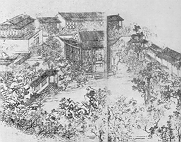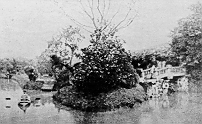 |
 |
 |
|
| |
|
|
 Notes
on the Gardens Notes
on the Gardens |
|
 |
| Garden
architecture has long been a tradition of China. Between
the middle of Ming dynasty and the earlier part of Qing
dynasty gardens began to thrive in Shanghai. Two famous
gardens Yu Yuan (Happy Garden) and Luxiang Yuan (Dew Fragrance
Garden) were constructed during the period. At the end
of the Qing dynasty and the beginning of the Republic
of China many more were built in this prosperous city.
Altogether there were more than one hundred gardens, large
and small, public and private. It was indeed a phenomenal
growth both in terms of number and speed of development.
|
 Yu Yuan
Yu Yuan |

Pleasure
boat with ornate lamps in Zhang Yuan
The gardens
were of many different types. The earlier ones kept
the traditional national style, with elegant bridges,
rippling streamlets, exquisite rockwork, waterside
pavilions, gorgeous flowers and precious trees. The
later gardens were influenced by Japanese and European
cultures, and had some of these characteristics. Quite
often indigenous and foreign designs were simultaneously
manifested in one garden. Also, foreign architectures
appeared in Chinese landscapes. Rare species of Western
and Chinese plants were seen growing side by side.
Meanwhile many gardens gradually lost their seclusiveness
and became profit-making enterprises. Since at that
time Chinese were rigorously excluded from the city
public gardens by the Shanghai Municipal Council of
the International Settlement, a number of private
gardens began to open to the public and sell tickets
for admission. In order to enhance their attractiveness,
entertainment facilities were introduced. Zhang Yuan
(Zhang Garden) was an outstanding example of these
gardens.
|

Xu Yuan

Weichun
Yuan
|
This garden
was situated at the corner of the present Nanjing Road
(West) and Taixing Road. It had been a country house of
a foreign businessman, but was bought by Zhang Shuhe from
Wuxi county. He enlarged and reconstructed the estate
and turned it into a garden, initially named Weichun Yuan
(Garden of Water Shield). Apart from ponds and rockeries,
weeping willows and bamboo groves, the garden featured
a modern building called Ankai (comfortable Elevation)
and a theater called Haitien Shenchu (Sea-Horizon Beauty).
Western restaurants, novel electric appliance and recreational
installations were added. Thus the garden attracted numerous
visitors. What is worth mentioning is that before the
downfall of the Qing dynasty, Zhang Yuan also served as
a political forum. Constitionalists, reformers and revolutionaries
all came to deliver speeches in the Ankai building. When
Dr. sun Yat-sen and another revolutionary Zou Rong spoke
here, these were big events for the citizens of Shanghai.
|
|
|
|
|
|
|
|
|
 |
 |
 |
|
|
|
|
|
|
|


